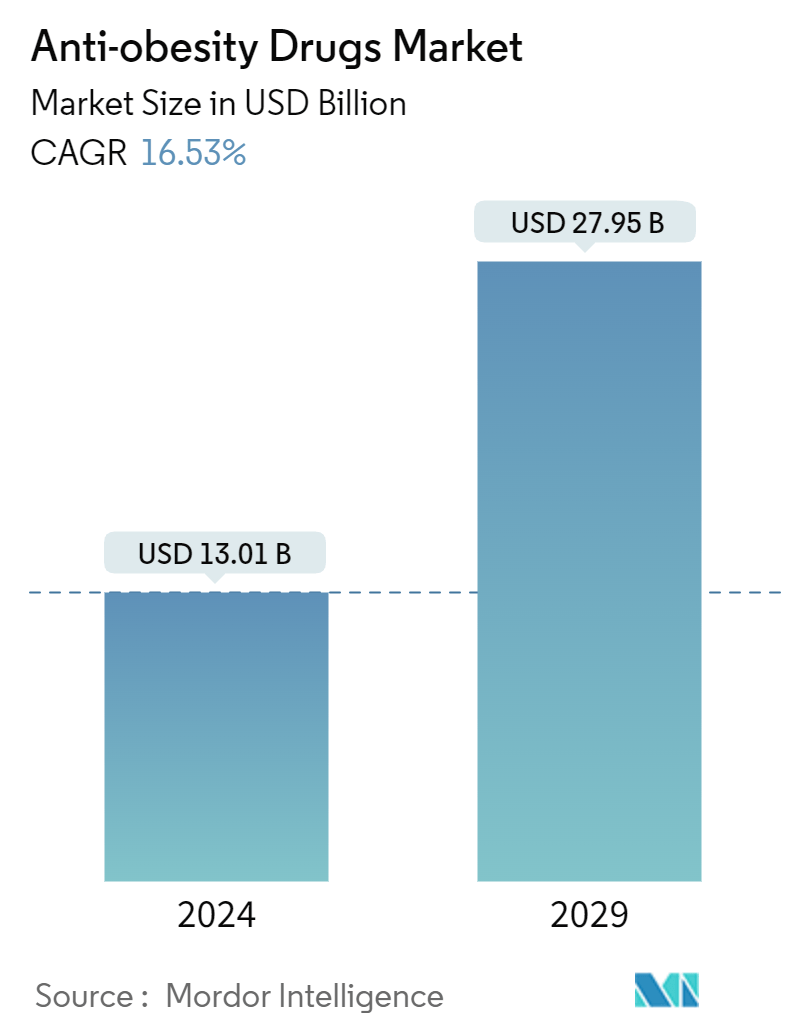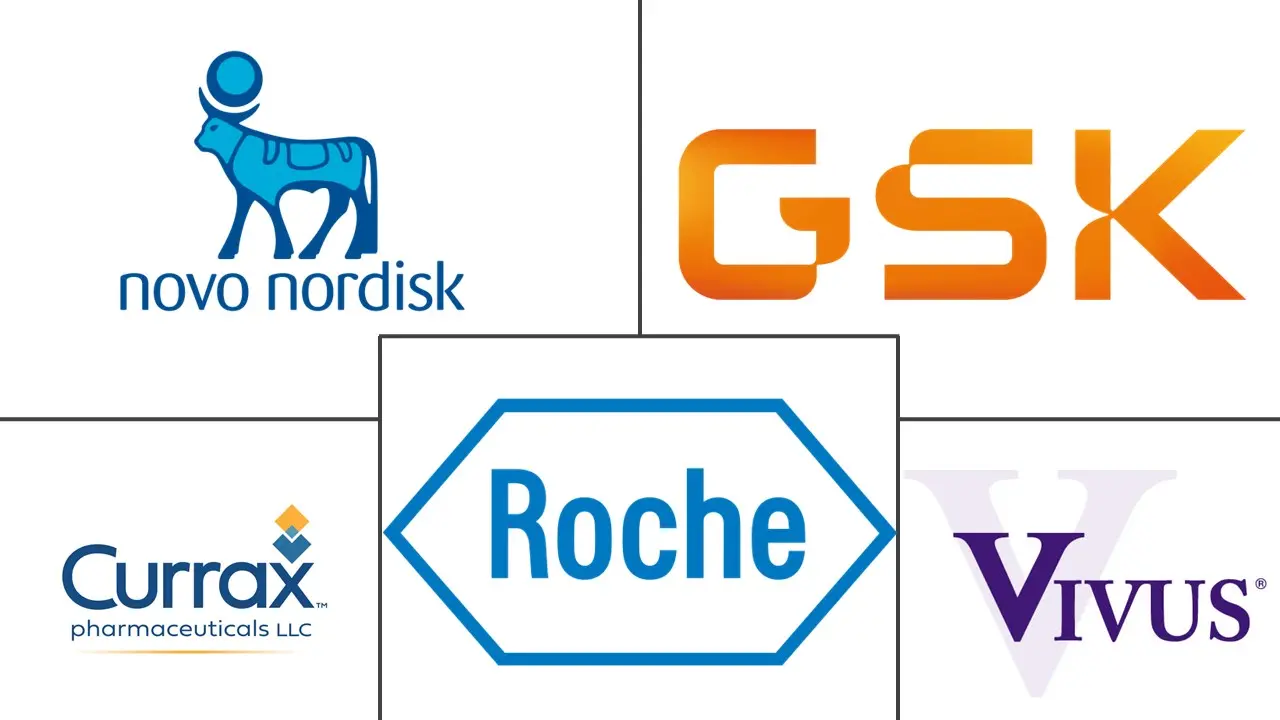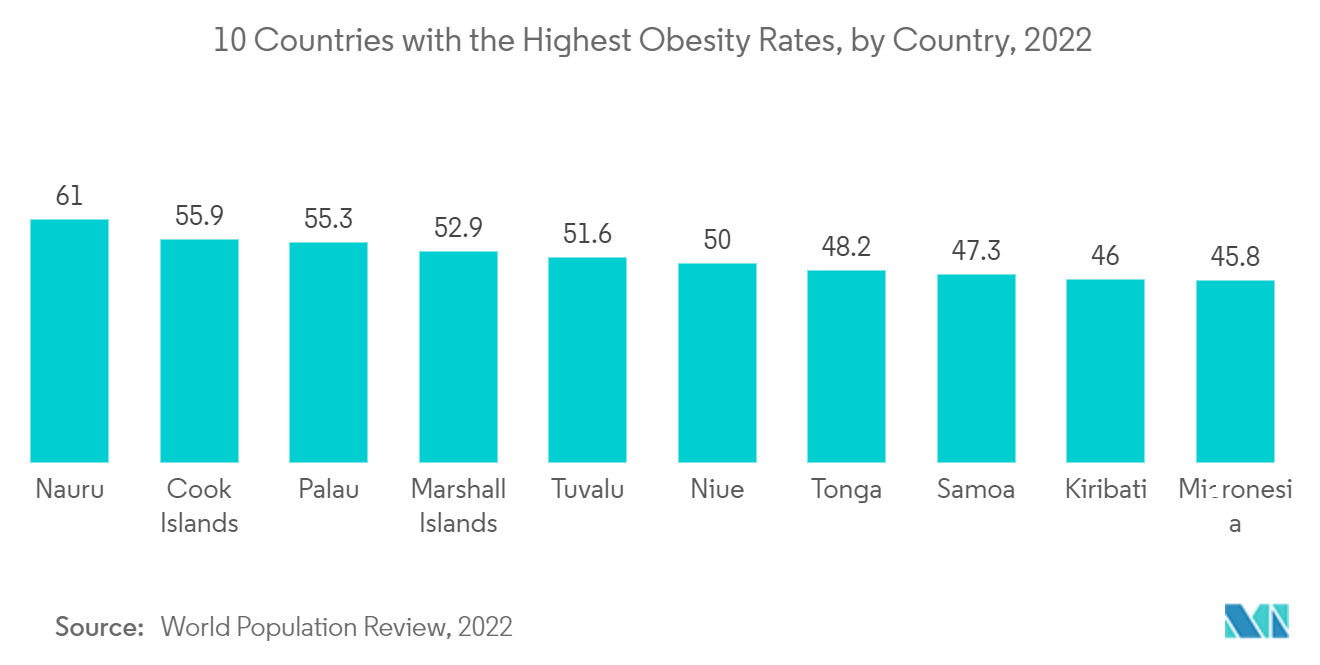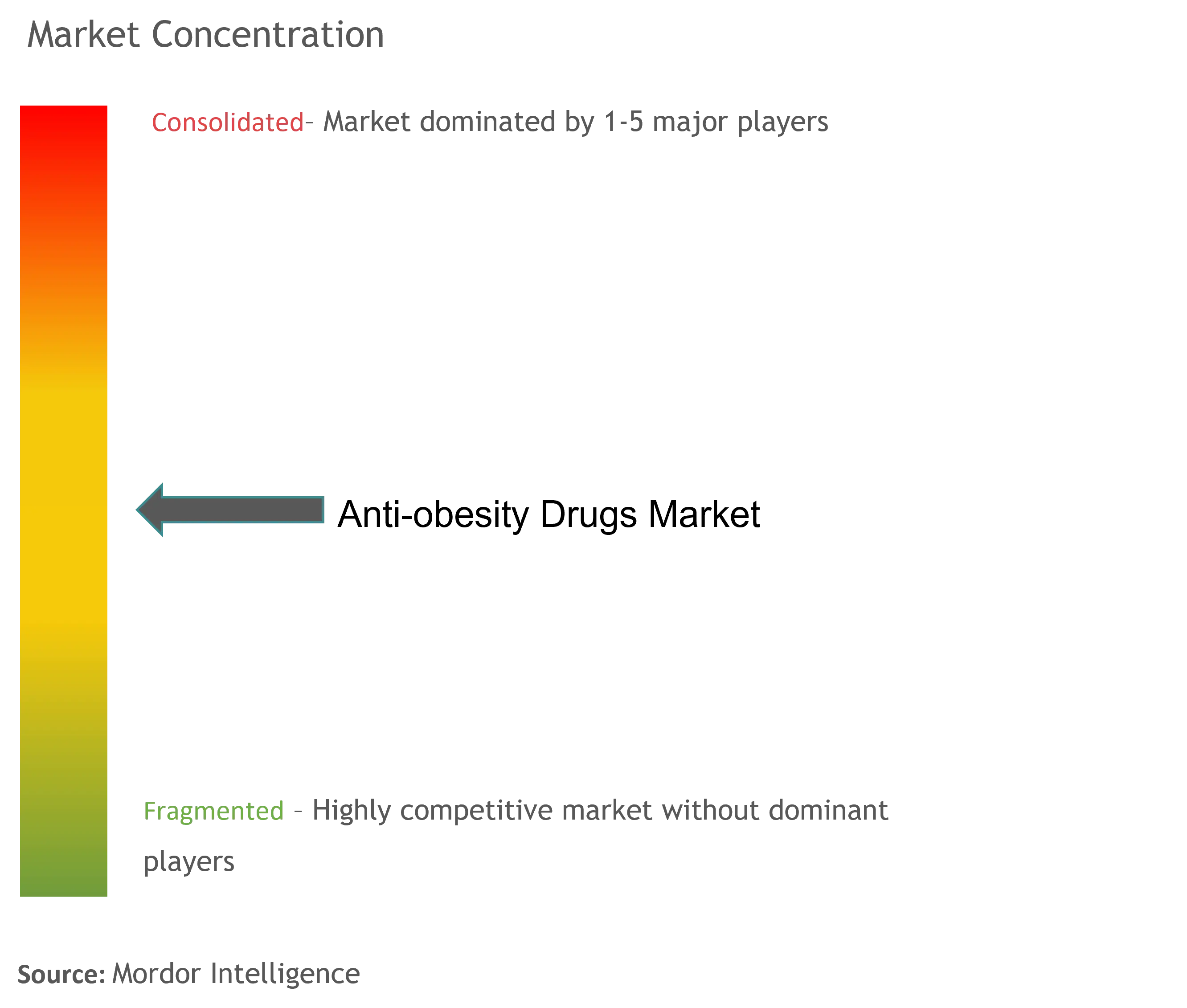Anti-Obesity Drugs Market Size

| Study Period | 2019 - 2029 |
| Market Size (2024) | USD 8.03 Billion |
| Market Size (2029) | USD 16.41 Billion |
| CAGR (2024 - 2029) | 15.37 % |
| Fastest Growing Market | Asia Pacific |
| Largest Market | North America |
| Market Concentration | Medium |
Major Players
*Disclaimer: Major Players sorted in no particular order |
Anti-Obesity Drugs Market Analysis
The Anti-obesity Drugs Market size is estimated at USD 13.01 billion in 2024, and is expected to reach USD 27.95 billion by 2029, growing at a CAGR of 16.53% during the forecast period (2024-2029).
During the COVID-19 situation, it was observed that obesity had increased exponentially. As per an article published by the European Journal of Nutrition in December 2020, the rate of obesity has increased in the world. The primary reason is a change in lifestyle and a decrease in exercise practice among people as they avoided gym and yoga classes due to the social distancing protocols. Similarly, according to the article published in Diabetes Obesity and Metabolism in August 2021, obesity prevalence is a significant and potentially modifiable risk factor for increased COVID-19 national caseload and mortality. This increased risk of the obese population leading to COVID-19 mortality which increased the demand for anti-obesity drugs during covid. However, increased awareness about healthy lifestyle and weight concerns during the pandemic are expected to maintain the demand of anti-obesity drugs even post-pandemic period.
According to the World Health Organization's report published in June 2021, 39 million children under the age of 5 years were overweight or obese in 2020. One in five children and adolescents globally is overweight. Incidences of obesity have been increasing fiercely over the past decades, and it is often described as a global endemic, especially in developed countries where lifestyle-related disorders, such as anxiety, stress, smoking, and drinking, are more prevalent. Owing to the increase in the obesity population worldwide, the key players in the market are initiating product developments and seeking market approvals. For instance, in January 2021, Novartis AG announced the results of its Phase II trial of the investigational product drug called Bimagrumab. The drug has shown potential for the indication of obesity. The drug is currently being studied in the Novartis pipeline. This may result in new treatment options, boosting market growth over the forecast period.
In addition, research on several potential drug molecules that target both obesity and Type 2 diabetes mellitus has become a key trend among the anti-obesity market players. The increasing epidemic of obesity and Type 2 diabetes is encouraging researchers and vendors in the market to research drugs that can counter both obesity and Type 2 diabetes. Hence, the increasing obese population, rise in unhealthy eating habits, and sedentary lifestyles are expected to drive the market growth over the forecast period.
However, the availability of alternative therapies and the potential side effects of anti-obesity drugs are expected to restrain the market growth.
Anti-Obesity Drugs Market Trends
The Prescription Drugs Segment is Expected to Exhibit a Faster Growth Rate Over the Forecast Period
By drug type, the prescription drug segment is expected to hold a significant market share. During the pandemic, different companies looked into new classes of medicines that help people lose weight and control diabetes as a possible way to fight the pandemic disease since COVID-19 had serious effects on the obese population. In June 2021, Novo Nordisk's weight-management drug received FDA approval. Such research and development activities are expected to propel the demand for prescription drugs. Moreover, the rising intake of junk foods and fast foods is resulting in declining health among the population worldwide, leading to an increase in the prevalence of obesity, especially in some developed parts of the world. For instance, according to the Eurostat report in July 2021, more than half (53%) were overweight (36% pre-obese and 17% obese) in Europe. Furthermore, for people aged 75 or over, the older the age group, the higher the share of overweight people: the lowest share was recorded among those aged 18 to 24 (25%), while those aged 65 to 74 had the highest share (66%). In June 2020, China Medical System Holdings signed a USD 400 million-plus agreement for Chinese commercialization rights to US biotech company Gelesis Inc.'s prescription obesity management product, Plenty. All these developments by the players, coupled with increasing awareness of prescription medicine, are anticipated to boost the growth of the prescription drugs segment.
Because of this, the above factors are likely to drive segment growth in the market over the next few years.

North America is Expected to Dominate the Market over the Forecast Period
North America is expected to dominate the global anti-obesity drugs market. The primary factors driving the growth of the market studied are the increase in the obese population and high healthcare spending. According to an article published by SingleCare Administrators, in February 2022, 1 out of every 3 U.S. adults is obese. Non-Hispanic black women experience the highest rates of obesity in America at 59%. Obesity rates are higher for Hispanic, Mexican American, and non-Hispanic black populations than for Caucasians. The South and the Midwest have the highest obesity prevalence. All U.S. states and territories have an obesity rate of at least 20%.
The high obesity rate has always attracted key players to make developments in the region. For instance, in 2020, Kintai Therapeutics, a US-headquartered company, announced that it was working across therapeutic areas and is beginning IND-enabling studies for its first potential therapeutic for treating obesity. The first drug candidate is KTX-0200, which has demonstrated sustained weight loss and improvements in other markers of health in animal models. The launch of these pipeline products and the increasing geographic footprints of the players are expected to propel the market growth in this region.

Anti-Obesity Drugs Industry Overview
The anti-obesity drug market is moderated due to the presence of companies operating globally and regionally. The competitive landscape includes an analysis of a few international as well as local companies that hold a significant market share and are well known, including GlaxoSmithKline PLC, Novo Nordisk AS, Pfizer Inc., F. Hoffmann-La Roche AG, and Bayer AG.
Anti-Obesity Drugs Market Leaders
-
Vivus
-
F Hoffmann-La Roche AG
-
GlaxoSmithKline PLC
-
Novo Nordisk AS
-
Currax Pharmaceuticals LLC
*Disclaimer: Major Players sorted in no particular order

Anti-Obesity Drugs Market News
- June 2021: the United States Food and Drug Administration (FDA) approved Semaglutide 2.4 mg for chronic weight management in adults with obesity or overweight with at least one weight-related condition (such as high blood pressure or cholesterol, or T2D) for use in addition to a reduced-calorie diet and increased physical activity.
- January 2021: Novo Nordisk AS signed a partnership with the startup Fauna Bio to identify new therapeutic approaches to obesity by studying the molecules and pathways that regulate metabolism in hibernating animals.
Anti-Obesity Drugs Market Report - Table of Contents
1. INTRODUCTION
1.1 Study Assumptions and Market Definition
1.2 Scope of the Study
2. RESEARCH METHODOLOGY
3. EXECUTIVE SUMMARY
4. MARKET DYNAMICS
4.1 Market Overview
4.2 Market Drivers
4.2.1 Increasing Burden of Obesity and Related Chronic Diseases
4.2.2 Growing Unhealthy and Sedentary Lifestyles
4.3 Market Restraints
4.3.1 Availability of Alternative Treatment Options
4.3.2 Side Effects of Drugs
4.4 Industry Attractiveness - Porter's Five Forces Analysis
4.4.1 Threat of New Entrants
4.4.2 Bargaining Power of Buyers/Consumers
4.4.3 Bargaining Power of Suppliers
4.4.4 Threat of Substitute Products
4.4.5 Intensity of Competitive Rivalry
5. MARKET SEGMENTATION
5.1 By Mechanism of Action
5.1.1 Peripherally Acting Drugs
5.1.2 Centrally Acting Drugs
5.2 By Drug Type
5.2.1 Prescription Drugs
5.2.2 OTC Drugs
5.3 Geography
5.3.1 North America
5.3.1.1 United States
5.3.1.2 Canada
5.3.1.3 Mexico
5.3.2 Europe
5.3.2.1 United Kingdom
5.3.2.2 Germany
5.3.2.3 France
5.3.2.4 Italy
5.3.2.5 Spain
5.3.2.6 Rest of Europe
5.3.3 Asia-Pacific
5.3.3.1 China
5.3.3.2 Japan
5.3.3.3 India
5.3.3.4 Australia
5.3.3.5 South Korea
5.3.3.6 Rest of Asia-Pacific
5.3.4 Middle-East and Africa
5.3.4.1 GCC
5.3.4.2 South Africa
5.3.4.3 Rest of Middle-East and Africa
5.3.5 South America
5.3.5.1 Brazil
5.3.5.2 Argentina
5.3.5.3 Rest of South America
6. COMPETITIVE LANDSCAPE
6.1 Company Profiles
6.1.1 Alizyme
6.1.2 Bayer AG
6.1.3 Bristol-Myers Squibb
6.1.4 Currax Pharmaceuticals LLC
6.1.5 F. Hoffmann-La Roche AG
6.1.6 GlaxoSmithKline PLC
6.1.7 Merck & Co. Inc.
6.1.8 Norgine BV
6.1.9 Novo Nordisk AS
6.1.10 Pfizer Inc.
6.1.11 Rhythm Pharmaceuticals
6.1.12 Takeda Pharmaceuticals
6.1.13 Vivus Inc.
6.1.14 Zafgan
6.1.15 Zydus Cadila
- *List Not Exhaustive
7. MARKET OPPORTUNITIES AND FUTURE TRENDS
Anti-Obesity Drugs Industry Segmentation
As per the scope of the report, anti-obesity drugs or weight loss medications are pharmacological agents that reduce or control weight. These medications alter one of the fundamental processes of the human body, weight regulation, by altering either appetite or absorption of calories. The anti-obesity drugs market is segmented by mechanism of action (peripherally acting drugs and centrally acting drugs), drug type (prescription drugs and OTC drugs), and geography (North America, Europe, Asia-Pacific, Middle-East and Africa, and South America). The market report also covers the estimated market sizes and trends for 17 different countries across major regions globally. The report offers the market size and forecasts in value (USD million) for the above segments.
| By Mechanism of Action | |
| Peripherally Acting Drugs | |
| Centrally Acting Drugs |
| By Drug Type | |
| Prescription Drugs | |
| OTC Drugs |
| Geography | ||||||||
| ||||||||
| ||||||||
| ||||||||
| ||||||||
|
Anti-Obesity Drugs Market Research FAQs
How big is the Anti-obesity Drugs Market?
The Anti-obesity Drugs Market size is expected to reach USD 8.03 billion in 2024 and grow at a CAGR of 15.37% to reach USD 16.41 billion by 2029.
What is the current Anti-obesity Drugs Market size?
In 2024, the Anti-obesity Drugs Market size is expected to reach USD 8.03 billion.
Who are the key players in Anti-obesity Drugs Market?
Vivus, F Hoffmann-La Roche AG, GlaxoSmithKline PLC, Novo Nordisk AS and Currax Pharmaceuticals LLC are the major companies operating in the Anti-obesity Drugs Market.
Which is the fastest growing region in Anti-obesity Drugs Market?
Asia Pacific is estimated to grow at the highest CAGR over the forecast period (2024-2029).
Which region has the biggest share in Anti-obesity Drugs Market?
In 2024, the North America accounts for the largest market share in Anti-obesity Drugs Market.
What years does this Anti-obesity Drugs Market cover, and what was the market size in 2023?
In 2023, the Anti-obesity Drugs Market size was estimated at USD 6.80 billion. The report covers the Anti-obesity Drugs Market historical market size for years: 2019, 2020, 2021, 2022 and 2023. The report also forecasts the Anti-obesity Drugs Market size for years: 2024, 2025, 2026, 2027, 2028 and 2029.
Anti-Obesity Drugs Industry Report
Statistics for the 2024 Anti-Obesity Drugs market share, size and revenue growth rate, created by Mordor Intelligence™ Industry Reports. Anti-Obesity Drugs analysis includes a market forecast outlook to 2029 and historical overview. Get a sample of this industry analysis as a free report PDF download.



